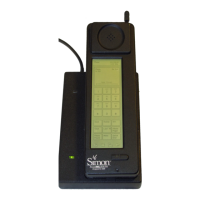3. Touch
New
Entry.
An Address
Book
form will
appear in
the
upper half
of the
screen. The
PredictaKey'
keyboard
appears
in the lower
half.
Learn
about
PredictaKey.
Simon
has
three
keyboards
that
you
can use to
enter information:
PredictaKey,
a numeric
<e1cad.
and
a
standard
keyboard.
you
can
::-:,:se
:he
keyboard
that
you
like
by touching
:-E
r.te--
!;:on
on any
keyboard.
Then touch
:e
(si=ca-is
sr:on.
and
make
your
selection.
F:,: nrcre
iniomaion.
see
-Using
Keyboards,,
on
page
67. For
this
practice.
iry using
PredictaKey,
developed
especially
to make
typing
easy
on
Simon.
The
PredictaKey
keyboard
always
shows the
six
most-likely
letters
that
you
need,
depending
on
the
characters
you've
just
typed.
lf
you
don,t
see
the letter
you
need,
touch
the
Other button
and
you
will
see the
next
most-likely
letters.
lf
you
type
a letter
accidentally,
backspace
with
the Bks
key.
To
type
one
capital
letter,
touch
Caps once.
For
Caps
lock,
touch
Caps
again. To
unlock
Caps, touch
Caps
one more
time.
For
punctuation,
touch
the
punctuation
(?,!)
button.
A
second
touch
will
lock
it. For
numbers,
touch
the
number (123)
button.
lt locks
automatically.
To
type
letters
again,
touch
the letters
(ABC)
button.
To move
to
the next
field in
a
form, touch
Enter.
You
can also move the cursor
(the
line
that
shows where typed letters will
appear) directly
by touching the screen with
the stylus where
you
want to type. lf
you
touch
a
field
name, the
cursor will appear in the first
typing
position
for
that field.
For
this exercise
type
the last name of
Smith.
The
cursor should be at LAST>. lf it isn't,
touch
LAST
to
move the
cursor there. Touch
Caps,
S, Other button,
m, i,
t, h, and Enter. Then
type the first name
of Simon. Touch
Caps, S, i,
m,
o, and
n. To
enter a
phone
number
of
555-1234, touch
Phone'l
(the
cursor
will
jump
to
Phonel in the form),
(123)
button, 555-1234,
and Done. Select the Home
button from the
pop-up
that lists
phone
number
labels.
Now
you
see the information
in the new
entry.
Notice that the options
that are available to
you
are
in
boxes
with
solid lines and the options
that
are
not
available at this time have
a broken
line
border.
From
this screen
you
can change
or erase the entry. You can touch
the Dial
Home
button
to
place
a call. You have
completed
your
first
Simon form. Most
of the
other features in Simon work
this same way.
Touch Erase to erase this
entry. Touch
OK.
Touch the Mobile
Office icon
or
the Phone
icon
to leave the
Address
Book.
5.
b.
7.
-
Trademark
of the IBM
Corporation.
14
User's
Guide
How
Simon Works 15

